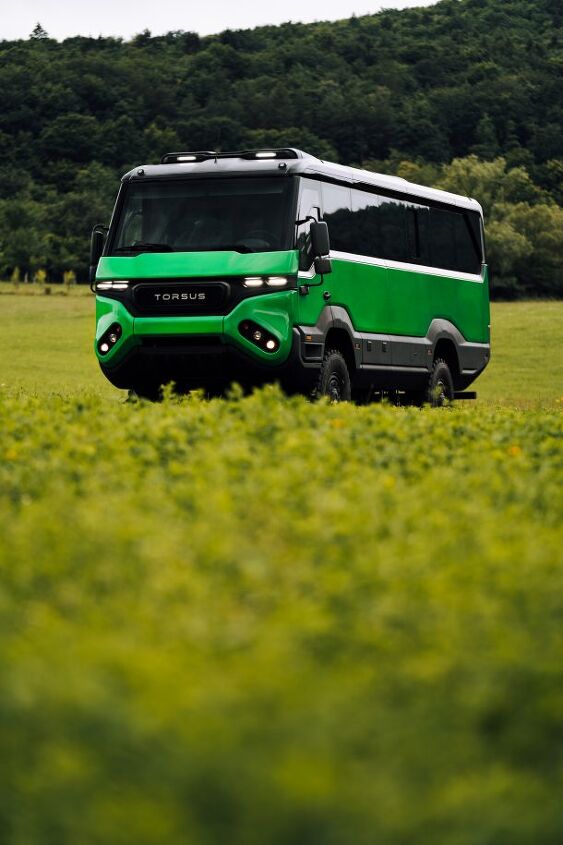Torsus Praetorian 4X4 Off-Road Bus Updated
Torsus’ Praetorian, heavy-duty, off-road 4X4 buses, has announced a number of technical advances. These rugged off-road buses are made to cross some of the most inhospitable terrains on earth.
Updates include LED lights, an advanced air conditioning system, passenger door, and pneumatic footsteps, a new fire system, and improved interior features.
Built to transport up to 35 passengers, a Praetorian can cross water up to three feet deep, according to the manufacturer.
Named after the Roman empire’s bodyguards, Praetorians are based on a MAN chassis. Power comes from a six-cylinder MAN diesel with 289 horsepower and 848 lb-ft of torque. Backed by a 4X4 off-road transmission, with Michelin XZL off-road tires, Torsus claims it can climb a 65 percent incline. A durable synthetic exterior coating provides impact resistance.
Torsus replaced the halogen headlights with WAŚ LEDs. WAŚ supplied W149 driving lamps, and 991 Signal SL roof and side-mounted work lights for 360-degree illumination.
Sold in Africa, Australia, Europe, and South America, the Praetorian works in the world’s hottest temperatures. These regions see outside temperatures as high as 122° Fahrenheit, and 140° Fahrenheit inside the bus.
Working with Webasto, Torsus improved the air-conditioning system. The A/C cools down the bus from 140° F to 86° F in three minutes, and 140° F to 68° F in under 15 minutes, such is its reported efficiency.
Torsus redesigned the Praetorian’s passenger door to comply with EU safety regulations. Pneumatic extending and retracting footsteps, and entrance bars provide ease of entry. An emergency evacuation system integrated into the doors, feature release buttons, and hatches. Do hatches refer to how you exit the vehicle if there’s a rollover?
Praetorian’s BlazeCut fire suppression system activates if there’s a fuel tank fire. System coverage extends to the engine compartment. Torsus added fire-resistant materials, fabrics, and fire extinguishers.
Driver’s seat visibility has been improved. Passengers have more space between the upgraded seats. Monitors in each seat allow the use of mobile electronics. New insulation materials in the vehicle walls and roof, and improved window sliders reduce energy consumption.
To handle extreme cold, the Praetorian has a Cello wall-mounted heating panel that generates radiant heat. Even if the outside temperature drops to 14°F, the heating panel will raise the temperature to 68°F, while using 19 percent less energy than conventional heating systems, according to Torsus.
Adventure tours, military operations, and other applications use Praetorians.
[Images: Torsus]
With a father who owned a dealership, I literally grew up in the business. After college, I worked for GM, Nissan and Mazda, writing articles for automotive enthusiast magazines as a side gig. I discovered you could make a living selling ad space at Four Wheeler magazine, before I moved on to selling TV for the National Hot Rod Association. After that, I started Roadhouse, a marketing, advertising and PR firm dedicated to the automotive, outdoor/apparel, and entertainment industries. Through the years, I continued writing, shooting, and editing. It keep things interesting.
More by Jason R. Sakurai
Latest Car Reviews
Read moreLatest Product Reviews
Read moreRecent Comments
- CEastwood I have a friend who drives an early aughts Forrester who refuses to get rid of it no matter all it's problems . I believe it's the head gasket eater edition . He takes great pains regularly putting in some additive that is supposed prevent head gasket problems only to be told by his mechanic on the latest timing belt change that the heads are staring to seep . Mechanics must love making money off those cars and their flawed engine design . Below is another satisfied customer of what has to be one of the least reliable Japanese cars .https://www.theautopian.com/i-regret-buying-a-new-subaru/
- Wjtinfwb 157k is not insignificant, even for a Honda. A lot would depend on the maintenance records and the environment the car was operated in. Up to date maintenance and updated wear items like brakes, shocks, belts, etc. done recently? Where did those 157k miles accumulate? West Texas on open, smooth roads that are relatively easy on the chassis or Michigan, with bomb crater potholes, snow and salt that take their toll on the underpinnings. That Honda 4 will run forever with decent maintenance but the underneath bits deteriorate on a Honda just like they do on a Chevy.
- Namesakeone Yes, for two reasons: The idea of a robot making decisions based on algorithms does not seem to be in anyone's best interest, and the thought of trucking companies salivating over using a computer to replace the salary of a human driver means a lot more people in the unemployment lines.
- Bd2 Powertrain reliability of Boxer engines is always questionable. I'll never understand why Subaru held onto them for so long. Smartstream is a solid engine platform as is the Veracruz 3.8L V6.
- SPPPP I suppose I am afraid of autonomous cars in a certain sense. I prefer to drive myself when I go places. If I ride as a passenger in another driver's car, I can see if that person looks alert and fit for purpose. If that person seems likely to crash, I can intervene, and attempt to bring them back to attention. If there is no human driver, there will probably be no warning signs of an impending crash.But this is less significant than the over-arching fear of humans using autonomous driving as a tool to disempower and devalue other humans. As each generation "can't be trusted" with more and more things, we seem to be turning more passive and infantile. I fear that it will weaken our society and make it more prone to exploitation from within, and/or conquest from the outside.





































Comments
Join the conversation
Make a cool camper van
"Torsus’ Praetorian, heavy-duty, off-road 4X4 buses, has announced a number of technical advances." Wow, the vehicle itself announced "a number of technical advances"? How very advanced of it.